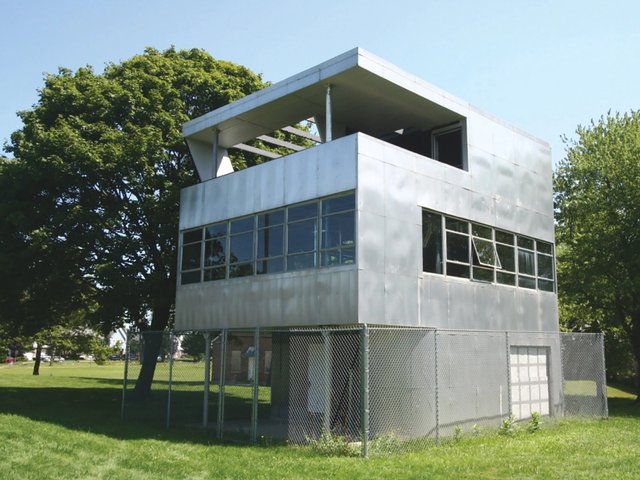After three years of travelling across the continent and sitting in a container, the iconic Aluminaire House designed by Albert Frey and A. Lawrence Kocher has found a future home on the grounds of the Palm Springs Art Museum in California. The boxy 1,100 sq. ft house was gifted to the museum by the Aluminaire House Foundation, founded by the architects and academics Michael Schwarting and Frances Campani.
“We think this is the perfect location and relationship to how the house will continue,” says Schwarting, who helped save the structure from demolition in the late 1980s. Palm Springs already boasts a number of Frey’s other landmark buildings, including the City Hall and the Tramway Gas Station.
Now the foundation has received a $100,000 grant from the Palm Springs Preservation Foundation to reassemble and display the three-storey historic structure while stipulating that it must be up by 2023. The Aluminaire House Foundation received a crucial certificate for appropriateness earlier this year from the city’s Historic Site Preservation Board to allow the installation of the building on the museum’s grounds.
Frey, a Swiss-born architect, is known as a father of Desert Modernism, a pathbreaker who concluded his long, illustrious career in the Coachella Valley but whose first US project was in New York. Soon after he arrived there from Paris, where he had worked for Le Corbusier, he was enlisted by Kocher, then the managing editor of the Architectural Record, to help design a house for the 1931 biennial expo of the Allied Arts and Industries/Architectural League of New York.
Created from ready-made materials, it became known as the Aluminaire House for its cladding of shimmering aluminum sheeting. As a pathbreaking all-metal prefabricated house, it was greeted as a sensation: it was intended to be mass-produced and affordable, using inexpensive components.
Afterwards it was privately purchased and disassembled and reinstalled several times until it fell into disrepair. In 1988 Schwarting arranged for the house to be donated to the New York Institute of Technology and moved to its Central Islip, Long Island campus as a teaching tool. However, when most of the campus closed in 2004, the house had to find a new home.
Plans to relocate the house in a historic preservation district in the New York neighbourhood Sunnyside, Queens, fell through in 2014 because locals felt the house would clash with their existing brick architecture. Then Schwarting and Campani were invited to speak at Modernism Week in Palm Springs, and “Everyone in the audience said, Bring it here!“ Schwarting recalls.
“We really wanted it in the public eye, as part of the city,” Campani adds. Both are especially pleased that it will also be near the steel-framed, glass-walled Frey House II, the architect’s own residence perched on a hill above the museum. That dwelling, she says, is “so telling of the work that was transformed by the desert, his late work.” The Frey House II was donated to Palm Springs Art Museum after Frey’s death along with the bulk of his original drawings and other archival material.
The museum, which is closed because of the coronavirus pandemic, “is pleased to add the Aluminaire to its permanent collection”, its executive director, Louis Grachos, wrote in an email. Building a foundation and re-assembling the house is expected to cost around $400,000, still being raised by the Aluminaire House Foundation.




